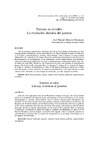Identificador persistente para citar o vincular este elemento:
https://accedacris.ulpgc.es/jspui/handle/10553/72313
| Title: | Turistas en el edén: La evolución literaria del paraíso | Other Titles: | Tourists at eden: Literary evolution of paradise | Authors: | Marrero Henríquez, José Manuel | UNESCO Clasification: | 55 Historia 6202 Teoría, análisis y crítica literarias |
Keywords: | Literary Landscape Paradise Tourism Canary Islands Publicity, et al |
Issue Date: | 2012 | Journal: | Revista de Literatura | Abstract: | After the first explorations beyond the Herculean Columns took place, the Canary Islands turned to be identified with classical myths, and literature (Cairasco de Figueroa, A. de Viana), historiography (L. Torriani, Abreu Galindo, Viera y Clavijo), natural science (Humboldt), and travellers (O. M. Stone) located there the paradisiac fantasies of the Islands of the Blessed, the Hesperids, the Fortunate Islands, and the Elysean Fields. Such identification will serve as publicity for the tourist exploitation that, since the end of the 19th century, will modify not only the islands landscape, but also its literary representation. In the works of Fco. Gonzalez Diaz, A. Quesada, C. Laforet, E. de Andrade, E. Junger, D. Lodge, L. Alemany, M. Houllebecq, L. Silva, or J. M. Marrero Henriquez classical imagery of paradise will reappear, either to ironically question its self-sufficiency as literary sign, to criticize its commercial use, as an image of desolation, or as an exigency for the future. Tras las primeras exploraciones realizadas más allá de las Columnas de Hércules, las Islas Canarias pasan a identificarse con los mitos clásicos y en ellas la literatura (Cairasco de Figueroa, A. de Viana), la historiografía (L. Torriani, Abreu Galindo, Viera y Clavijo), la ciencia natural (Humboldt) y los viajeros (O. M. Stone) ubican las ensoñaciones paradisiacas de las Islas de los Bienaventurados, de las Hespérides, de las Afortunadas, de los Campos Elíseos. Esta identificación será el abrevadero publicitario en el que se fundamentará la explotación turística que, desde finales del siglo XIX, alterará no sólo el paisaje de las islas, sino también su representación literaria. En la obra de Fco. González Díaz, A. Quesada, C. Laforet, E. de Andrade, E. Jünger, D. Lodge, L. Alemany, M. Houllebecq, L. Silva o J. M. Marrero Henríquez reaparecerá la imaginería del paraíso, ya para cuestionar con ironía su autosuficiencia como signo literario, ya para criticar su uso mercantil, ya como imagen de desolación, ya como exigencia de futuro |
URI: | https://accedacris.ulpgc.es/handle/10553/72313 | ISSN: | 0034-849X | DOI: | 10.3989/revliteratura.2012.01.301 | Source: | Revista De Literatura [ISSN 0034-849X], v. 74 (147), p. 11-30 |
| Appears in Collections: | Artículos |
Page view(s)
191
checked on May 31, 2025
Download(s)
166
checked on May 31, 2025
Google ScholarTM
Check
Altmetric
Share
Export metadata
Items in accedaCRIS are protected by copyright, with all rights reserved, unless otherwise indicated.
